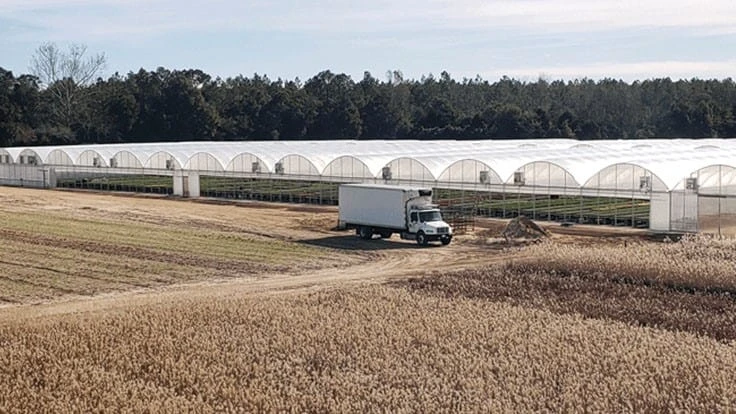

Across half a million acres of production space, Emerald Coast Growers (ECG) owner Paul Babikow estimates that 60 to 70% of its greenhouses were developed and built by Atlas Greenhouse.
“We’ve been gradually shifting from hoop houses to more efficient gutter-connected, high-wall houses,” he says. “This provides more cost-effective heating during the winter months, and better control of air movement during the hot, humid months.”
ECG propagates ornamental grass and perennial liners, as well as various native plants, across two sites in the Florida panhandle and another up in the heart of Pennsylvania Amish country outside Lancaster.
Obviously, those are two very different growing climates. The certainty in producing a consistent, well-performing crop that Atlas Greenhouse provides makes working with the builder an easy choice for Babikow and Emerald Coast Growers. In fact, the grower just recently opened the doors on a new 2-acre perennial facility, designed and built by Atlas.
“The structure includes a gathering/loading headhouse on the west end and perennial production houses on the east end with two 1-acre gutter blocks in between,” Babikow says. “This new setup provides us with an efficient flow of product from sticking to shipping and the high walls allow for improved air flow and ultimately a better environment for perennial growing.”


And a better growing environment means a better season financially for ECG, as well as happier customers who are more likely to buy again.
Yet, there is a multitude of active greenhouse structures companies in the industry today. So how did ECG come to choose Atlas as its main commercial partner on so many of these projects?
“Convenient southeast location, service and the quality of structure made Atlas an easy choice for our greenhouse needs,” Babikow says.
That easy choice came into play again recently when ECG got started on a new project for an extended headhouse to connect their new perennial facility with four older gutter-connected blocks to improve their material handling.
Babikow says that this latest ongoing project requires a bit of ingenuity from the Atlas team, who have been very hands-on through the entire process, including multiple in-person site visits.
“This install requires connectivity to some non-Atlas structures, as well as Atlas houses,” he says. “After 30 years in business, we have a bit of a mix of old and new structures, with a need to make everything work together the best that we can. Atlas, for its part, has been an essential part of that effort.”

Explore the September 2020 Issue
Check out more from this issue and find your next story to read.
Latest from Greenhouse Management
- CEA Alliance celebrates bipartisan introduction of Supporting Innovation in Agriculture Act
- Dümmen Orange North America celebrating 25th anniversary in 2025
- Illinois Landscape Contractors Association changes name to Landscape Illinois
- 2025 Proven Winners Horticulture Scholarship applications now open
- ICL’s Gemini Granular herbicide now registered for use in California
- Eurazeo Planetary Boundaries Fund acquires Bioline AgroSciences
- Spring Meadow Nursery's Freedom Shelley finds joy in plants
- Leading Women of Horticulture: Dana Massey, Plantworks Nursery






